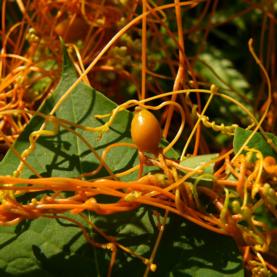Reproduction
Reproduction of Cuscuta pentagona actually fits the normal angiosperm schema, unlike its vegetative structures and means for nutrient acquisition. Reproduction begins with clusters of flowers that are small and white or yellow (Ombrello) needs to be pollinated. Cuscuta uses flowers to attract pollinators.
The structure of a flower consists of male and female reproductive structures. The female structures are collectively referred to as the pistil, while the male reproductive structures are called the stamen. The stamen consists of the filament and anther. The filament holds the anther on top of it. The filaments are arranged around the pistil within the flower petals. The stamen's purpose is to create pollen, or microspores. Pollen is carried by the wind, water, or pollinators like Hymenoptera, Diptera, and Lepidoptera. Pollen's final destination lies in the pistil. The pollen is caught on the stigma, which sits at the top of the style. The style connects the stigma to the ovary. Once the pollen lands on the stigma, it digests its way through the style to the ovary, where pollination takes place. The fruit is formed and the seeds are held inside of it.
Each fruit holds one to four seeds (Ombrello). Each plant
produces about one thousand seeds (Cook, 2006).
This huge number of seeds explains the rapid spread of dodder.
The seeds can be moved by animals, shoes, with soil movement, or
water movement (Ombrello). The seeds can be moved without
the fruit as well. Dodder has a tough seed coat that gives
a great amount of protection to the seed, allowing it to stay in
the soil dormant for up to sixty years (Cook, 2006).
Germination of seeds begins under certain conditions.
Cuscuta seeds require temperatures
 between 15 to 35
degrees Celsius (Cook, 2006). More about Cuscuta pentagona finding
and using a host for nutrients can be read in
Adaptation and
Nutrition respectively.
between 15 to 35
degrees Celsius (Cook, 2006). More about Cuscuta pentagona finding
and using a host for nutrients can be read in
Adaptation and
Nutrition respectively.
Reproduction of Cuscuta pentagona can be asexual as well. If a stem part is placed on a host, a haustorium will grow and Cuscuta will grow a new plant (Cook, 2006).
Click here to go to Interactions.
Click here to go Home.

